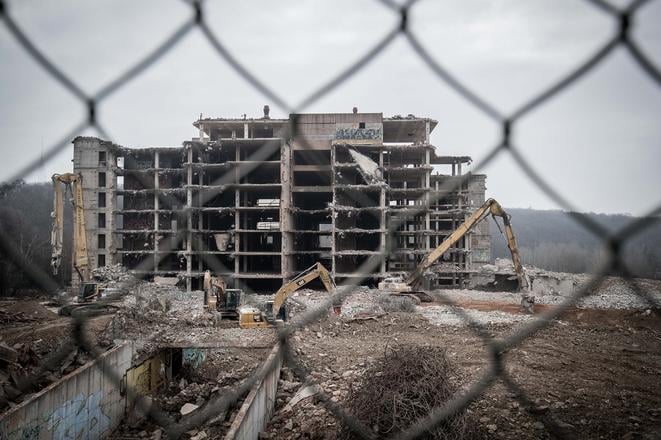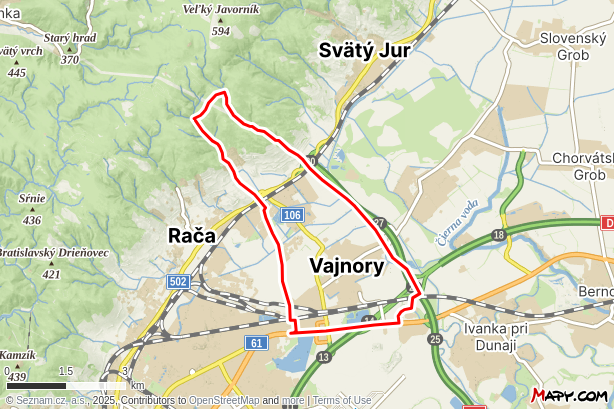A woman was struck in the head by a large chunk of falling plaster while attending a medical appointment with her children at a Trnava clinic, in an incident that came to light just as the Slovak government unveiled a long-delayed plan to build a new national hospital in Bratislava.
According to reports by tvnoviny.sk, a popular news website, the incident occurred at the Družba polyclinic, where a slab of ceiling roughly measuring a square metre came crashing down during an examination. A nurse, acting quickly, warned the mother to move the pram carrying her seven-month-old baby, just before the debris hit. The woman, also accompanied by her three-year-old son, was later diagnosed with a mild concussion and sustained an elbow injury.
Health ministers
Ľubomír Javorský (1994–1998) – HZDS
Tibor Šagát (1998–2000) – SDK
Roman Kováč (2000–2002) – SDK
Rudolf Zajac (2002–2006) – SDKÚ-DS
Ivan Valentovič (2006–2008) – Smer
Richard Raši (2008–2010) – Smer (now Hlas)
Ivan Uhliarik (2010–2012) – KDH
Zuzana Zvolenská (2012–2014) – Smer
Viliam Čislák (2014–2016) – Smer
Tomáš Drucker (2016–2018) – Smer (now Hlas)
Andrea Kalavská (2018–2020) – Smer
Marek Krajčí (2020–2021) – OĽaNO
Vladimír Lengvarský (2021–2023) – OĽaNO (nominee)
Zuzana Dolinková (2023–2024) – Hlas
Kamil Šaško (2024–present) – Hlas
The timing of the accident cast an uncomfortable spotlight on the state of Slovakia’s public healthcare facilities, as Interior Minister and Hlas party leader Matúš Šutaj Eštok and Health Minister Kamil Šaško (Hlas) unveiled plans for a long-promised National University Hospital in Bratislava. To be named after General Milan Rastislav Štefánik, the hospital will be constructed on land owned by the Defence Ministry in the eastern borough of Vajnory.
Funded primarily through the EU Recovery Plan, with nearly €200 million allocated, the facility is expected to break ground this autumn. It will offer top-tier, level-five care, with 950 beds – including 150 for intensive care – and serve over 44,000 patients annually across 150 outpatient departments.
The ministers described the project as a milestone for Slovak healthcare, envisioning a full medical, educational, and research complex that includes a relocated National Institute for Children’s Diseases and a potential new campus for the Comenius University Medical Faculty.
Critics, however, are sceptical. Opposition figures warned that routing the project through the Defence Ministry could enable the government to bypass public procurement rules. The ministry could make procurements under a classified regime, potentially driving up the cost of the project. “I suspect this is a way to siphon off public funds,” said KDH MP Peter Stachura, as quoted by the TASR news agency. On April 30, the government designated the project a strategic investment, clearing the way for an accelerated construction timeline for the hospital. Others, including former health minister Marek Krajčí (Slovensko), questioned how the state would staff and finance the project, with the overall cost reportedly reaching €1.2 billion. He believes that government officials are once again building castles in the air.
Moreover, near the site of the planned new hospital, Economy Minister Denisa Saková of the Hlas party owns property, according to a report by Denník N. The opposition party Progressive Slovakia has called on Saková to transfer her land in Vajnory to the state at its pre-announcement appraised value, citing a potential conflict of interest.
The announcement marks yet another chapter in Slovakia’s decades-long struggle to build a flagship hospital in the Slovak capital. The original plan, dating back to the communist era, envisioned a national hospital at Rázsochy, a site where construction was eventually abandoned in 2019 after €50 million had already been spent. In 2022, the previous government recommitted to Rázsochy, budgeting €281 million and setting a completion date for this year. That project, however, was quietly shelved last year by then-health minister Zuzana Dolinková (Hlas), who favoured a Ružinov location.
Meanwhile, in stark contrast to the state’s decades-long delays, the Penta private investment group completed and opened a state-of-the-art hospital in the Bory district of Bratislava in 2023.
Now, with Vajnory chosen, ministers insist that they are on a faster and firmer path. Yet even those who welcome Vajnory as the location, like SaS MP Tomáš Szalay, have warned that unless transparency is ensured, the new timeline is unlikely to hold. The ministers said the hospital is expected to open by 2030. “The wait for a decision has lasted half a century,” Szalay said. “Let this be the final one.”
Timeline of the national hospital project in Bratislava
1969 – Public tender announced for a new teaching hospital with a polyclinic.
1982 – Government decision to begin the hospital project; planning begins.
1985 – Project documentation approved; site preparations and land purchases start.
1986 – Project included in the state development plan.
1987 – Building permit issued; construction begins. Completion was scheduled for 1993.
1991 – Construction halted.
1995 – Investor begins updating project documentation.
1997 – Project expanded to include ICU, heliport, and ambulance ramp.
2000 – Government of Mikuláš Dzurinda halts project financing.
2001 – Nearly one billion Slovak korunas invested in Rázsochy by this time.
2003 – Government suspends work and proposes to sell the site.
2010 – Minister Richard Raši (then Smer, now Hlas) proposes completing the hospital for €480 million (excluding VAT).
2013 – Minister Zuzana Zvolenská (Smer) proposes a new hospital at the military site in Patrónka for €250 million.
2015 – State announces €6.3 billion tender for a private partner.
2016 – Minister Tomáš Drucker cancels Patrónka plan, revives Rázsochy proposal.
2018 – Government approves demolition of existing structure for €17 million.
2019 – Demolition launched by PM Peter Pellegrini (Hlas) and Minister Andrea Kalavská. Public procurement launched for new project preparation.
2022 – Government allocates €281 million from the EU Recovery Plan; contracts signed for design and feasibility studies.
2023 – Finance Ministry under Eduard Heger proposes removing Rázsochy from the recovery plan and reallocating funds.
2024 – Minister Zuzana Dolinková (Hlas) announces plan to build national hospital in Ružinov.
2025 – Minister Kamil Šaško (Hlas) announces new plan to build the hospital in Vajnory, in cooperation with the Defence Ministry.


 Demolition of the Rázsochy hospital in Bratislava in January 2020 (source: Sme - Jozef Jakubčo)
Demolition of the Rázsochy hospital in Bratislava in January 2020 (source: Sme - Jozef Jakubčo)
